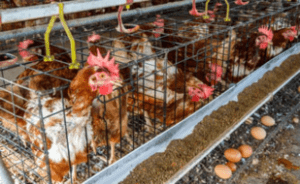Read on for your Egg-ucation!
Cheaper conventional eggs? Free range, cage-free, or pastured? Vegetarian grain-fed, omega-3 enhanced, or organically fed? Organic free range? Organic caged? During my Smart Shopping trips with clients, we stand in front of the egg refrigerator at my grocery store where I teach about the different eggs that are available to buy. Something as simple as buying a carton of eggs should not be as confusing as it has become, but with all of the different labels and laws that are trying to govern the growing practices of our day, make it almost impossible to understand, so most people just go with cheap. Please read on so that you can make a wise decision about where to spend your hard-earned money. Here are some details that can help you make a decision about what is best for you and your family.
As we look at the six types of chickens and eggs they produce, we will follow this format: Housing. Feed.
- Conventional Chickens
Housing: Where do they live?
“Poultry husbandry has evolved over the years to maximize both the production efficiency of the chicken and the profit from the systems employed. This is the reasons (sic) that producers use cages for laying hens.”
–Letter to the USDA from the United Egg Producers
 Image: Conventional chicken farm via Shutterstock
Image: Conventional chicken farm via Shutterstock
In other words, it has become about how to make more money.
The hens unfortunate enough to be a part of building the coffers of those whose bottom line we are talking about spend their brief lifespan piled together with a half-dozen other hens in a wire cage about the size of 4 pages of an average book laid out. Every natural instinct given to them by their creator is thwarted, leading to frustrated, angry, animals who develop sad behavior that can include cannibalizing her cagemates or rubbing her breast against the wire mesh until it is completely raw and bleeding. (Documented)
Conventional hens live in cages stacked one on top of another in a large henhouse and they NEVER see the outside world. Conventional hens lead unenviable lives, crammed together in filthy cages, with no opportunity to follow their chicken instincts (i.e., nest, scratch, brood, or even stretch their wings), are tricked into laying eggs incessantly without necessary fallow periods, and are debeaked so they don’t peck each other to death. Enough said?
Feed: What do they eat?
These protein machines eat enough to keep them alive and laying a large number of cheap eggs. Their feed can be made of some combination of the following: processed chicken and other livestock carcasses, poultry litter, plastic pellets for roughage, grains, some of which are genetically modified, and loads of antibiotics to combat the diseases that run rampant in the overcrowded cages. Yummy!
- Feed-Enhanced: Grain-Fed/Vegetarian/Omega-3
Housing: Where do they live?
The answer to this is basically the same as conventional chickens. Unless “grain-fed” or “omega-3” accompanies the phrases “cage-free” or “free range,” it does not mean the quality of the chickens’ lives is any better than conventional chickens. This simply refers to their feed. This is only buzz-word marketing – Omega-3 enriched eggs.
Feed: What do they eat?
“Grain-fed” is a distinction overseen by the Agricultural Marketing Service. These chickens are fed grains like soy, corn, and canola, to name a few. Although chickens by nature are not vegetarians, this is admittedly a step up from conventional feed since this vegetarian feed doesn’t include processed animal carcasses or poultry litter. So, no poop in their porridge. J Unfortunately, three of the grains fed to these animals are the most commonly grown genetically modified crops in the United States.
Grain-fed often accompanies the omega-3-enhanced label. That usually means the chickens have been fed flaxseed and/or seaweed to create the illusion of a more nutrient-dense egg, but be careful here.
- Organic Chickens
Housing: Where do they live?
Chickens that have been certified as USDA organic can technically live in cages, but they are more likely to be cage-free or free range to minimize the outbreak of disease that the overcrowding in cages encourages.
Animals who get sick and have to be treated with antibiotics and other medicines will lose their organic standing, either temporarily during the course of their treatment or permanently.
The organic label also means that livestock must have access to the outside: “continuous total confinement of any animals indoors is prohibited.” This is another reason that caged chickens would be unlikely candidates for organic certification.
Possible exemptions to the outdoor standard include the following:
- inclement weather
- the animal’s stage of life
- conditions under which the healthy, safety, or well-being of the animal could be jeopardized
- risk to soil or water quality
The United Egg Producers waste no time in finding a way around these stipulations. They write that “access to the outdoors will actually increase the spread of disease and parasites.”
In direct response to the organic outdoor standards, they claim that “access to the outdoors can be achieved in housing design with open-sided curtains on poultry confinement houses. Weather permitting, the curtain sidewalls can be raised to allow fresh air and direct sunlight.”
Furthermore, the UEP claims that animal welfare would actually be aided by the use of cages: “The natural pecking among poultry can be reduced in a caged environment.” The UEP concludes the letter with a suggestion that the USDA create new labels: cage organic and cage-free organic, so when you see those terms at your grocery store, this is what they’re referring to. That said, organic is certainly a step up, but it is a guarantee that chickens have spent much if any, time outside.
Feed: What do they eat?
The USDA-regulated word “organic” means that the animal feed must be free of unnecessary additives, antibiotics, genetically modified organisms, animal by-products, and “feed formulas containing manure,” just to name a few. See the full list over at the USDA.
- Cage-Free Chickens
Housing: Where do they live?
Cage-free means just that: The chickens are not confined to cages. The USDA states that the birds may “freely roam a building, room, or enclosed area with unlimited access to food and fresh water during their production cycle.” This is one step up from conventional battery cages, but cage-free chickens still live in very close quarters.
Feed: What do they eat?
Unless otherwise specified with the organic or grain-fed label, cage-free birds are fed conventional feed.
- Free-Range Chickens
Housing: Where do they live?
Free-range birds live in houses like their cage-free brethren, but they must have “access to the outdoors” for 51 percent of their lives. The key word here is “access.” There are doors in the chicken house that are opened after the chickens have grown accustomed to their surroundings.
One free-range farmer at a local farmers’ market was asked if these chickens actually go outside, and he said they almost never do since they feel safer with what they know and feel no compulsion to explore when their food and water are in the house. The USDA’s Federal Safety and Inspection Service notes the problem of free-range growers being certified as such “regardless of whether the birds use the yard.”
Feed: What do they eat?
I think “free range” can be a particularly deceptive marketing tactic because it implies that chickens are allowed to act like chickens in the fresh air foraging outside, but in reality, they’re not going outside to eat often, if ever.
Free-range chickens that eat organic, non-GMO feed do exist and their eggs are a much better option, but unless otherwise specified, free-range birds eat the same thing that conventional chickens do. They just have a little bit more space.
- Pastured Chickens
Where do they live?
The USDA does not have a standardized definition of what pastured means because there can be many variables involved. But by any reasonable definition, these birds should spend a large part of their day outside in grass foraging for their food, following their chicken instincts. Since domesticated chickens have lost the ability to fly, they must have protection from predators so they can safely roost and can brood over a nest.
What do they eat?
Of the six egg laying types we’re looking at, pastured hens alone are encouraged to exercise their instinct to scratch, peck, and eat bugs. But there’s a lot of variety within this category, so if you’re concerned about GMOs, you’ll need to ask your farmer how he supplements his hens’ diet–the AMS does differentiate between organic and non-organic pastured hens, even if it doesn’t provide pasture-raised certification. Don’t be afraid to ask–get to know your farmer and his practices.
I trust only Vital Farms because pasture raised is all they do! All versions are available at Whole Foods Market where I shop, but here is their claim from their website. I love that they call their hens “the girls” and “girls on grass” is their slogan. These are beautiful, happy, healthy hens. Eggs the way The Creator intended.
The girls are free to roam and forage as much as they like – we open the barn doors in the morning, and out they all go! We make sure there’s plenty of shade out on the pastures, and a ready supply of both clean, fresh water and our carefully formulated supplemental feed, but they’re free to come and go from the barn, and free to eat what they want, all day long. Every one of our farms follows the same Certified Humane® pasture-raised standards, so the only real difference between our different labels is whether it Certified Organic, NonGMO Project Verified, or neither. The shields you’ll see below, which you’ll also see on our cartons, will tell you which it is. https://vitalfarms.com
HERE’S THE BEST REASON TO CONSIDER THE SOURCE OF YOUR EGGS!
Nutritional Benefits Abound. If I’ve learned one thing in my research and eating, it’s that all eggs are not created equal, and I hope you can see this now too. Changes to the living conditions of the chickens and/or the feed available to them result in different eggs, both in size, color, appearance, and most important to me, nutritional density.
According to the study I found on the subject, pastured eggs are the clear winner.
They have less of the bad stuff
- 1/3 less cholesterol than conventional eggs
- 1/4 less saturated fat than conventional eggs
They also have more of the good stuff:
- 2/3 times more vitamin A
- 2 times more omega-3 fatty acids
- 3 times more vitamin E
- 4 to 6 times as much vitamin D
- 7 times more beta-carotene
Although pastured eggs may seem more expensive, they are nutritionally denser than their conventional counterparts and are actually a better value. A pastured egg costs $.29, and a conventional egg is about $.14; however, we’d have to eat three conventional eggs to get the same levels of omega-3s, vitamin A, and vitamin E. We’d have to eat a whopping seven conventional eggs to match the vitamin D and beta-carotene in pasture-raised eggs.
So looking at it from a nutritional standpoint, pastured eggs are the better bargain. They seem like they’re twice as much, but you’re really not comparing the same thing. Pastured eggs are an entirely different thing, nutritionally speaking.
If the nutritional differences don’t convince you, try cooking with pasture-raised eggs.
–the yolk is a perfect puffed circle, firm and bright marigold orange.
How to find pasture-raised eggs
- Vital Farms – https://vitalfarms.com
- Find a farmers’ market. Don’t be afraid to ask a farmer where his hens live and what they eat. Keep asking egg farmers if their chickens eat bugs until you find one who knowingly says “yes.”
- Check out comfort pasture-raised options near you.
- localharvest.com is also a good resource.
- Slow Food USA is a great place to start building a community.
- Keep your own egg-laying hens. Many cities permit one or more hens in urban areas, and the symbiotic relationship between the hens and garden is amazing. Use non-GMO feed.









Follow Me